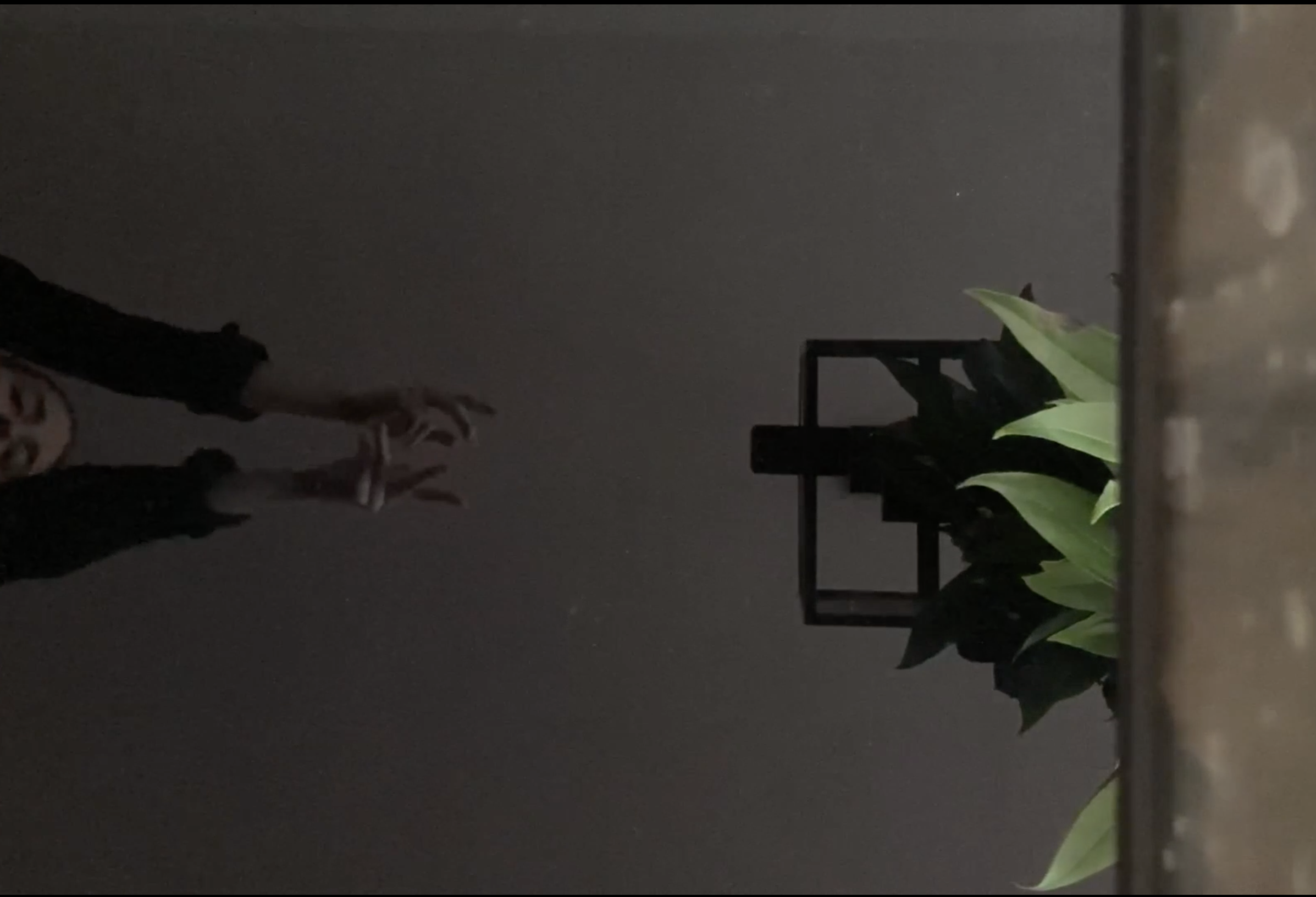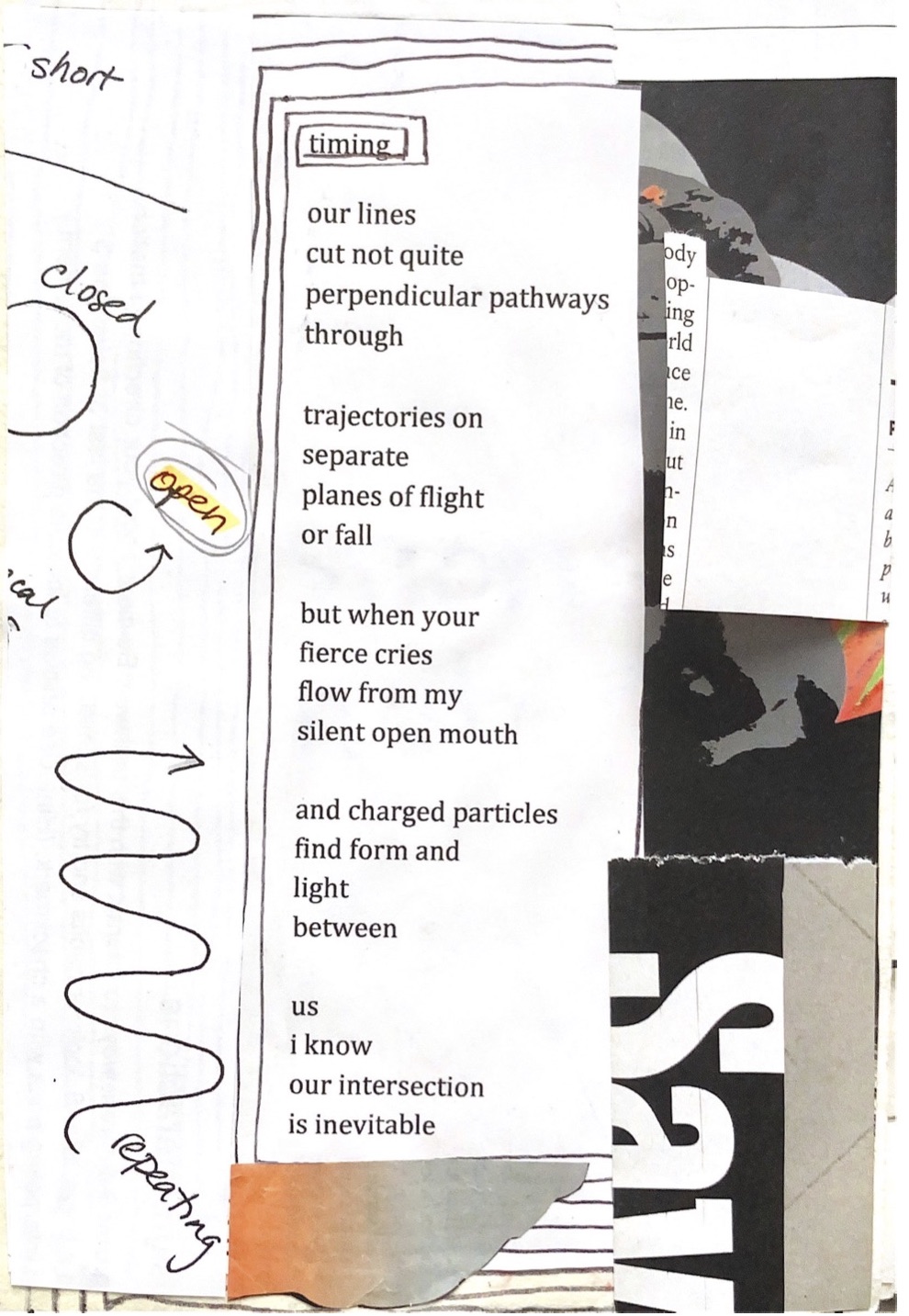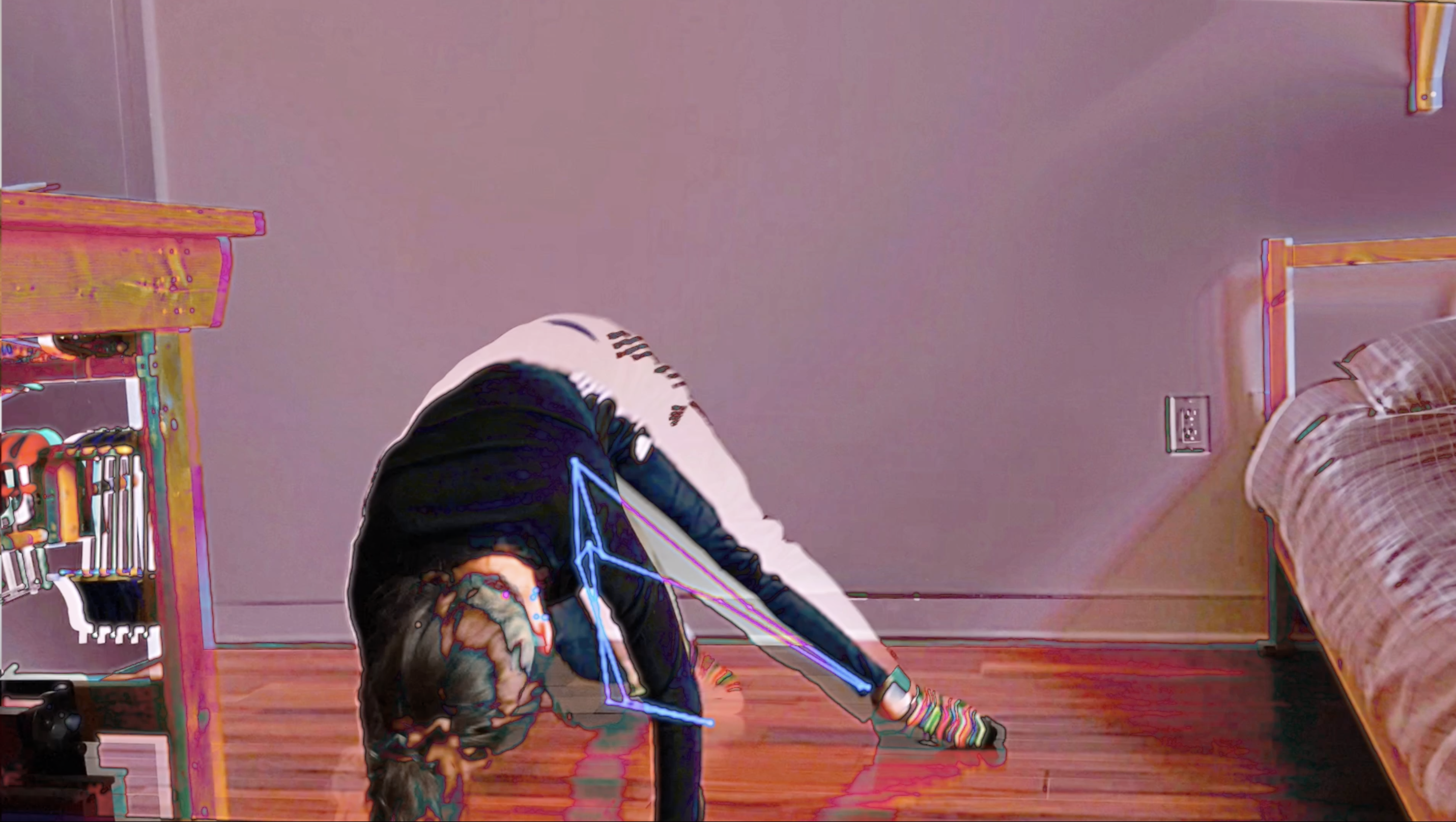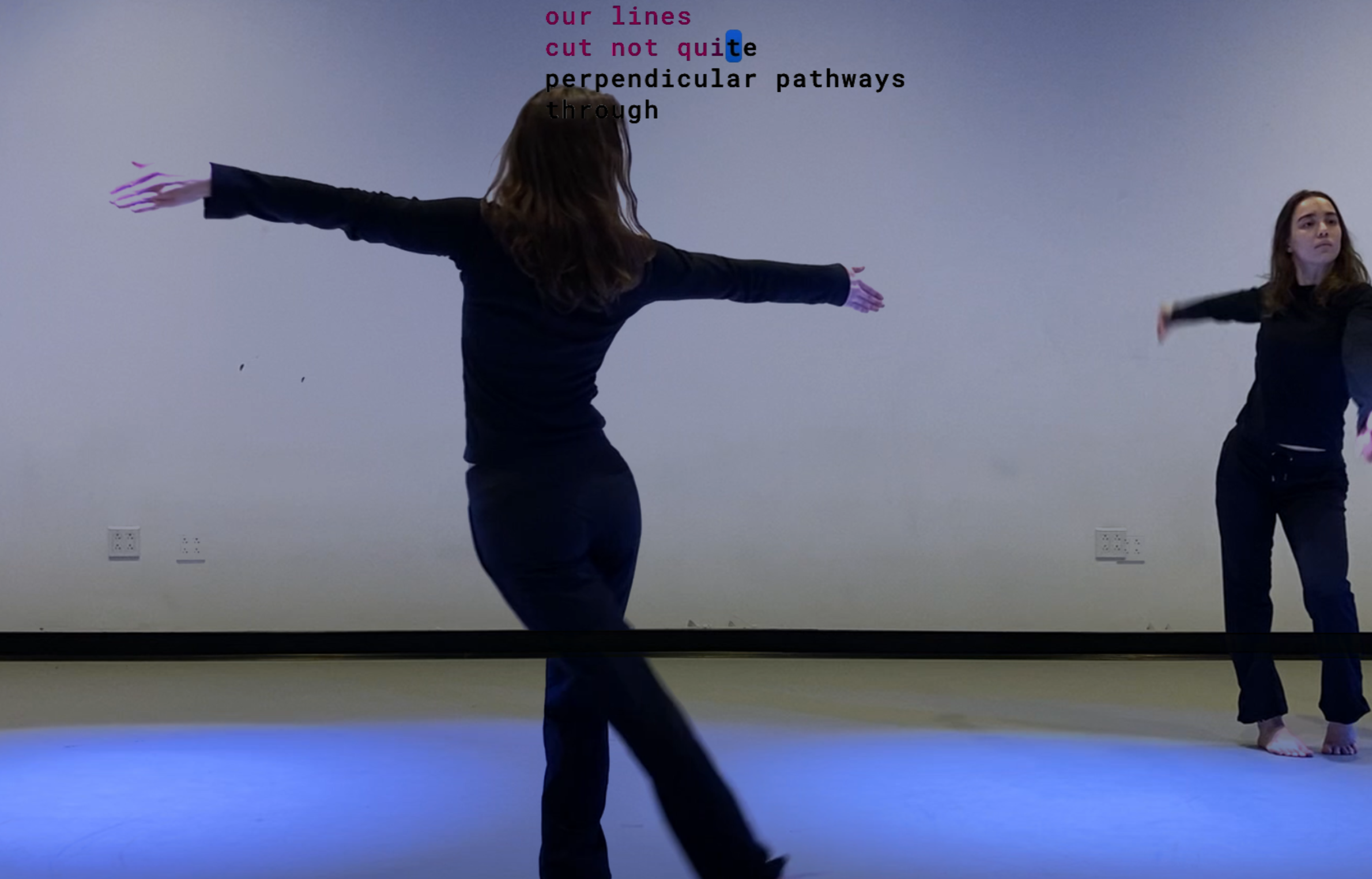On space and place in the digital
Usually, when you take a dance class in-person, one of the main “materials” is the studio. However, in virtual dance classes, we are now inhabiting two unique spaces: both the screen and our own personal rooms, which have things like beds and tables in them. This difference turns essentially all virtual dancing into site specific work, regardless of intentionality. Understanding how movement changes in these new spaces, of the digital and of the home, so that intention can be added, is where the work has the potential to become art.
There's an Italian saying I love,“traduttore, traditore,” which basically means, “to translate is to betray.” It’s this idea that you can't transmit an idea from place to place; you're not going to be able to reproduce it in another space, or in another language or another context. The artwork of translation is in finding what evokes the same emotional response. For instance, how does eye contact translate into the digital? If I look at your eyes on my screen it looks like I’m looking down, so perhaps I stare into the camera, but perhaps eye contact on Zoom isn’t translated by looking but through a personal message on the chat. Dance needs to find what that true translation is from live to digital, rather than trying to create a duplication or transmission.
On the body and embodiment
How I live in my body changes based on what my body is doing and the context or space my body is in, and once I understand that I have more flexibility to push back and try to inhabit my body and the space in new ways. Here my body is in Zoom, where you can see my shoulders, but the lower half of my body is just gone. How do I remember that I have toes, and let you know that I have them too? Is it through my face that I’m communicating that I have toes? Or do I show you my toes and say, “See? They’re there too!”
Even before the pandemic, you would go on the subway, and nobody's looking at each other, they're all looking at their cell phones. If somebody is choking, do you notice that? Or are you too plugged in that the digital is, in some ways, more the world or context you are living in than what’s actually around you? We’ve become conscious of technology’s draw and power, and how the impact of our digital lives affects our lived experience even when we are off-line. How do you center your body within that? Centering the brain and body in a specific place always takes time and effort, and we must realize that those specific spaces include both the digital world and the physical world. Without acknowledging it, we cannot create strategies to reclaim ownership of where our bodies are and what our bodies are doing within these spaces.
I’ve also been thinking about avatar making, and how the ability to actually embody other bodies online brings up so many questions for me. Unreal Engine has this new software called MetaHuman, and one of their first prototype people is this Black woman. What does it mean that all of these people are mapping their facial expressions onto this Black woman's avatar? And who is this person? Does she get informed and compensated each time other people animate her face with their own expressions?
On labor and replication in the virtual
As artists, even in the real world, there needs to be greater demand for pay for the work we do. Yet, how do you demand to be paid for something that does not have the same materiality as things in the real world, and yet also has the ability to be duplicated and replicated and manipulated in ways real world things can't be? If I give you my motion capture data, is it now yours, and you never have to pay me again for it? And if you want to mix it with somebody else's, do I get a say in how my movements are being changed? Dance already has a lot of issues with intellectual property because of its ephemerality. I think the digital world just adds more layers to those questions. There has to be better education and clear contracts to create rules of engagement with material that's digital, because otherwise, it’s a free for all. And that place of uncertainty will always put the artists at a disadvantage, vulnerable for exploitation.
On abstraction and glitch feminism
In addition to dance, I practice other art forms including collage and poetry. I've been trying to find ways to use the digital in a more abstract and symbolic way. Adding layering and poetry, in the sense of multiple interpretations, is where I've been finding space in the digital that feels more comfortable and authentic to me. I've been veering away from trying to make projects look more and more realistic, and instead trying to build in the digital like a collage, adding layers to make the space feel more 3D, at least to me.
In the digital, I think you have to have a certain amount of awareness or wariness when it comes to not just what you are seeing but also the platforms you are seeing it on. Even the question of who’s made this screen that I’m looking at you on: Apple. What does Apple stand for? What about the platform of Zoom? Who does it include or exclude? Critical thinking about the digital spaces and how they were designed is necessary in addition to the typical critical thinking we do around content.
I believe very strongly in glitch feminism, which I learned about from Legacy Russell’s book Glitch Feminism: A Manifesto. There's really important room in places where the digital has glitch, which provides space where the imagination can augment the digital and help turn it into art. Glitch feminism argues that despite most digital spaces having been designed by white men in the typical hierarchical structures that mainly support people who have access to funds and education and all of these different resources, there is still the possibility for practices within the digital that subvert its own corporate structures by embracing the glitch. The digital is a great place for world building for anybody, as you can push back against applications by creating spaces within them with your own rules and practices. Exposing and living vibrantly within those spaces, regardless of your identity as someone of the “intended” target audience, is in many ways its own form of activism. Art in general is not the intended use of the digital. How do you push into the glitch of it?
One of the platforms I used most in my post baccalaureate project is PoseNet, which is an artificial intelligence TensorFlow model for pose estimation. It doesn't recognize a lot of dance shapes because it's not used to seeing skeletons in weird positions. It does these really bizarre things: sometimes it makes you fly, other times your skeleton is shown as just a pile of crinkly lines and dots. Instead of being frustrated, that's where I get really intrigued. It is an artificial intelligence, and so how is it that by doing these different movements I’m affecting the system, and yet not enough for it to register when I'm in a handstand?
On the screen
How you view your relationship with the screen changes how people move in front of it, so defining your relationship with the image is very important. I've had classes where instructors say, “Use your screen as a mirror.” Then our real world experience with mirrors is affecting our relationship with the screen and our own image of ourselves. Especially for many dancers, that instant visual feedback often focuses us on the aesthetic and affects our movement differently than if we are visualizing the screen as a window or as something we are supposed to ignore.
When the screen is on, people tend to be rather aware of it. I don't think the screen’s power or impact immediately goes away when you turn off your sound or video. Our spatial awareness, especially in dance, tends to extend to the borders of the virtual space. If I go out of frame, what does that mean? Am I worried because you're only seeing part of me? Or is that a space of respite where I'm like, “Oh, nobody can see me, great, I can do my own thing. [Laughing].” So, I think there's a lot of play involved. I think my answer to most questions about the digital is to add more play. Yet even with that, you still have to be clear about what your relationship is with the virtual image and how it affects you.
On virtual teaching and learning
With online teaching, I've noticed an increase in practices focusing on centering your body, as we realize how much time and effort it takes to be present in the body and the moment that you're in. There also seems to be more flexibility with expectations about how people are inhabiting their bodies; I’ve noticed in a lot of dance classes that teachers are giving more options for modification. If you're doing movement phrases differently than how they were demonstrated, it's not necessarily going to be corrected in the same way that I’ve often experienced in the real world. There is a certain forgiveness for, "Oh, you know, I can't do that on the ground thing, because I don't have enough ground space. So I'm going to do it standing.” And it's not wrong, it is just modifications for embodying the space that you're in and the body that you're in. I believe the resulting flexibility allows for an increase in embodiment and in accessibility, because it lets you show up as you are. I'm curious about how that's going to change or affect changes to expectations during in-person classes.





